Design and Application of Low-Temperature Geothermal Thermoelectric Power Generation (Lotemg–TPG) in Sari Ater Hot Spring, Ciater, Subang, West Java, Indonesia
Abstract
:1. Introduction
2. Methods
2.1. Lotemg–TPG Test and Application Site
2.2. Research Stages
2.3. Device Manufacture and Performance Test of Lotemg–TPG
3. Results and Discussion
3.1. TEG Element Type TEG1-241-1.4-1.2 and M8T Module
3.2. Lotemg–TPG Unit Block Frame and Laboratory Test
3.3. Application and Field Test of Lotemg–TPG Unit at Sari Ater Hot Springs
4. Conclusions
Author Contributions
Funding
Data Availability Statement
Acknowledgments
Conflicts of Interest
References
- Rizaty, M.A. Kapasitas PLTP Indonesia Terbesar Kedua Di Dunia Pada 2022. Available online: https://dataindonesia.id/energi-sda/detail/kapasitas-pltp-indonesia-terbesar-kedua-di-dunia-pada-2022 (accessed on 13 March 2023).
- Bina, S.M.; Jalilinasrabady, S.; Fujii, H.; Pambudi, N.A. Classification of Geothermal Resources in Indonesia by Applying Exergy Concept. Renew. Sustain. Energy Rev. 2018, 93, 499–506. [Google Scholar] [CrossRef]
- Hochstein, M.P. Classification and Assessment of Geothermal Resources; Dickson, M.H., Fanelli, M., Eds.; UNITAR/UNDP: Rome, Italy, 1990; pp. 31–57. [Google Scholar]
- Ronald DiPippo Geothermal Power Plants: Principles, Applications, Case Studies and Environmental Impact; Elsevier: Amsterdam, The Netherlands, 2015; ISBN 9780081008799.
- Nasution, A.; Kartadinata, M.N.; Kobayashi, T.; Siregar, D.; Sutaningsih, E.; Hadisantono, R.; Kadarstia, E. Geology, Age Dating and Geochemistry of the Tangkuban Parahu Geothermal Area, West Java, Indonesia. J. Geotherm. Res. Soc. Jpn. 2004, 26, 285–303. [Google Scholar] [CrossRef]
- Sentosa, R.A.; Haryanto, N.S.A.D.; Gentana, D. Land Surface Temperature Pada Manifestasi Permukaan Panasbumi: Studi Kasus Gunung Tangkuban Parahu, Jawa Barat. Padjadjaran Geosci. J. 2018, 2, 376–386. [Google Scholar]
- Rana, S.; Orr, B.; Iqbal, A.; Ding, L.C.; Akbarzadeh, A.; Date, A. Modelling and Optimization of Low-Temperature Waste Heat Thermoelectric Generator System. Energy Procedia 2017, 110, 196–201. [Google Scholar] [CrossRef]
- Remeli, M.F.; Tan, L.; Date, A.; Singh, B.; Akbarzadeh, A. Simultaneous Power Generation and Heat Recovery Using a Heat Pipe Assisted Thermoelectric Generator System. Energy Convers. Manag. 2015, 91, 110–119. [Google Scholar] [CrossRef]
- Hettiarachchi, H.D.M.; Golubovic, M.; Worek, W.M.; Ikegami, Y. Optimum Design Criteria for an Organic Rankine Cycle Using Low-Temperature Geothermal Heat Sources. Energy 2007, 32, 1698–1706. [Google Scholar] [CrossRef]
- Yu, K.; Zhou, Y.; Liu, Y.; Liu, F.; Hu, L.; Ao, W.; Zhang, C.; Li, Y.; Li, J.; Xie, H. Near-Room-Temperature Thermoelectric Materials and Their Application Prospects in Geothermal Power Generation. Geomech. Geophys. Geo-Energy Geo-Resour. 2020, 6, 12. [Google Scholar] [CrossRef]
- Velmre, E. Thomas Johann Seebeck (1770–1831). Est. J. Eng. 2007, 13, 276. [Google Scholar] [CrossRef]
- Rowe, D.M. Review, Thermoelectric Waste Heat Recovery as a Renewable Energy Source. Int. J. Innov. Energy Syst. Power 2006, 1, 13–23. [Google Scholar]
- Snyder, G.J. Small Thermoelectric Generators. Electrochem. Soc. Interface 2008, 17, 54–56. [Google Scholar] [CrossRef]
- Jaziri, N.; Boughamoura, A.; Müller, J.; Mezghani, B.; Tounsi, F.; Ismail, M. A Comprehensive Review of Thermoelectric Generators: Technologies and Common Applications. Energy Rep. 2020, 6, 264–287. [Google Scholar] [CrossRef]
- Abdel-Motaleb, I.M.; Qadri, S.M. Thermoelectric Devices: Principles and Future Trends. arXiv 2017, arXiv:1704.07742. [Google Scholar]
- Zulkepli, N.; Yunas, J.; Mohamed, M.A.; Hamzah, A.A. Review of Thermoelectric Generators at Low Operating Temperatures: Working Principles and Materials. Micromachines 2021, 12, 734. [Google Scholar] [CrossRef] [PubMed]
- Zoui, M.A.; Bentouba, S.; Stocholm, J.G.; Bourouis, M. A Review on Thermoelectric Generators: Progress and Applications. Energies 2020, 13, 3606. [Google Scholar] [CrossRef]
- Ravindra, N.M.; Jariwala, B.; Bañobre, A.; Maske, A. Thermoelectrics; SpringerBriefs in Materials; Springer International Publishing: Cham, Switzerland, 2019; ISBN 978-3-319-96339-6. [Google Scholar]
- Northwestern_University Thermoelectric Properties of Materials. Available online: https://thermoelectrics.matsci.northwestern.edu/thermoelectrics/index.html (accessed on 22 November 2021).
- Twaha, S.; Zhu, J.; Yan, Y.; Li, B. A Comprehensive Review of Thermoelectric Technology: Materials, Applications, Modelling and Performance Improvement. Renew. Sustain. Energy Rev. 2016, 65, 698–726. [Google Scholar] [CrossRef]
- Lee, H. Thermoelectrics: Design and Materials, 1st ed.; John Wiley & Sons, Inc.: Hokoben, NJ, USA; Western Michigan University: Kalamazoo, MI, USA, 2017; ISBN 9781118848951. [Google Scholar]
- Rowe, D.M. Thermoelectrics Handbook Macro to Nano; CRC Press: Boca Raton, FL, USA, 2006; ISBN 9781315220390. [Google Scholar]
- Ahiska, R.; Mamur, H. Design and Implementation of a New Portable Thermoelectric Generator for Low Geothermal Temperatures. IET Renew. Power Gener. 2013, 7, 700–706. [Google Scholar] [CrossRef]
- Liu, C.; Chen, P.; Li, K. A 500 W Low-Temperature Thermoelectric Generator: Design and Experimental Study. Int. J. Hydrogen Energy 2014, 39, 15497–15505. [Google Scholar] [CrossRef]
- Ziapour, B.M.; Saadat, M.; Palideh, V.; Afzal, S. Power Generation Enhancement in a Salinity-Gradient Solar Pond Power Plant Using Thermoelectric Generator. Energy Convers. Manag. 2017, 136, 283–293. [Google Scholar] [CrossRef]
- Kumar, S.; Roy, D.; Ghosh, S. Thermodynamic Assessment of TEG-ORC Combined Cycle Powered by Solar Energy. Int. J. Renew. Energy Technol. 2017, 8, 346. [Google Scholar] [CrossRef]
- Zare, V.; Palideh, V. Employing Thermoelectric Generator for Power Generation Enhancement in a Kalina Cycle Driven by Low-Grade Geothermal Energy. Appl. Therm. Eng. 2018, 130, 418–428. [Google Scholar] [CrossRef]
- Gholamian, E.; Habibollahzade, A.; Zare, V. Development and Multi-Objective Optimization of Geothermal-Based Organic Rankine Cycle Integrated with Thermoelectric Generator and Proton Exchange Membrane Electrolyzer for Power and Hydrogen Production. Energy Convers. Manag. 2018, 174, 112–125. [Google Scholar] [CrossRef]
- Khanmohammadi, S.; Saadat-Targhi, M.; Al-Rashed, A.A.A.A.; Afrand, M. Thermodynamic and Economic Analyses and Multi-Objective Optimization of Harvesting Waste Heat from a Biomass Gasifier Integrated System by Thermoelectric Generator. Energy Convers. Manag. 2019, 195, 1022–1034. [Google Scholar] [CrossRef]
- Maneewan, S.; Chindaruksa, S. Thermoelectric Power Generation System Using Waste Heat from Biomass Drying. J. Electron. Mater. 2009, 38, 974–980. [Google Scholar] [CrossRef]
- Hsu, C.-T.; Huang, G.-Y.; Chu, H.-S.; Yu, B.; Yao, D.-J. Experiments and Simulations on Low-Temperature Waste Heat Harvesting System by Thermoelectric Power Generators. Appl. Energy 2011, 88, 1291–1297. [Google Scholar] [CrossRef]
- Niu, X.; Yu, J.; Wang, S. Experimental Study on Low-Temperature Waste Heat Thermoelectric Generator. J. Power Sources 2009, 188, 621–626. [Google Scholar] [CrossRef]
- Suter, C.; Jovanovic, Z.R.; Steinfeld, A. A 1kWe Thermoelectric Stack for Geothermal Power Generation—Modeling and Geometrical Optimization. Appl. Energy 2012, 99, 379–385. [Google Scholar] [CrossRef]
- Li, K.; Garrison, G.; Moore, M.; Zhu, Y.; Liu, C.; Horne, R.; Petty, S. An Expandable Thermoelectric Power Generator and the Experimental Studies on Power Output. Int. J. Heat Mass Transf. 2020, 160, 120205. [Google Scholar] [CrossRef]
- Lee, K.-T.; Lee, D.-S.; Chen, W.-H.; Lin, Y.-L.; Luo, D.; Park, Y.-K.; Bandala, A. An Overview of Commercialization and Marketization of Thermoelectric Generators for Low-Temperature Waste Heat Recovery. iScience 2023, 26, 107874. [Google Scholar] [CrossRef]
- Xie, H.; Gao, T.; Long, X.; Sun, L.; Wang, J.; Xia, E.; Li, S.; Li, B.; Li, C.; Gao, M.; et al. Design and Performance of a Modular 1 Kilowatt-Level Thermoelectric Generator for Geothermal Application at Medium-Low Temperature. Energy Convers. Manag. 2023, 298, 117782. [Google Scholar] [CrossRef]
- Ahiska, R.; Mamur, H. Development and Application of a New Power Analysis System for Testing of Geothermal Thermoelectric Generators. Int. J. Green Energy 2016, 13, 672–681. [Google Scholar] [CrossRef]
- Li, K.; Garrison, G.; Zhu, Y.; Moore, M.; Liu, C.; Hepper, J.; Bandt, L.; Horne, R.; Petty, S. Thermoelectric Power Generator: Field Test at Bottle Rock Geothermal Power Plant. J. Power Sources 2021, 485, 229266. [Google Scholar] [CrossRef]
- Catalan, L.; Aranguren, P.; Araiz, M.; Perez, G.; Astrain, D. New Opportunities for Electricity Generation in Shallow Hot Dry Rock Fields: A Study of Thermoelectric Generators with Different Heat Exchangers. Energy Convers. Manag. 2019, 200, 112061. [Google Scholar] [CrossRef]
- Marpaung, H.; Singarimbun, A.; Srigutomo, W.; Lasmi, N.K. Thermoelectric Application of TEG1-241-1.4-1.2 for Power Generation from Low Temperature Geothermal Fluid. Adv. Sci. Technol. 2023, 126, 67–77. [Google Scholar] [CrossRef]
- Zhang, Z.; Wu, Y.; Li, W.; Xu, D. Performance of a Solar Thermoelectric Power-Harvesting Device Based on an All-Glass Solar Heat Transfer Pipe and Gravity-Assisted Heat Pipe with Recycling Air Cooling and Water Cooling Circuits. Energies 2020, 13, 947. [Google Scholar] [CrossRef]
- Morais, F.; Carvalhaes-Dias, P.; Duarte, L.; Spengler, A.; De Paiva, K.; Martins, T.; Cabot, A.; Dias, J.S. Optimization of the TEGs Configuration (Series/Parallel) in Energy Harvesting Systems with Low-Voltage Thermoelectric Generators Connected to Ultra-Low Voltage DC-DC Converters. Energies 2020, 13, 2297. [Google Scholar] [CrossRef]
- Liao, J.; Xie, H.; Wang, J.; Sun, L.; Long, X.; Li, C.; Gao, T.; Xia, E. Effect of Operating Conditions on the Output Performance of a Compact TEG for Low-Grade Geothermal Energy Utilization. Appl. Therm. Eng. 2024, 236, 121878. [Google Scholar] [CrossRef]

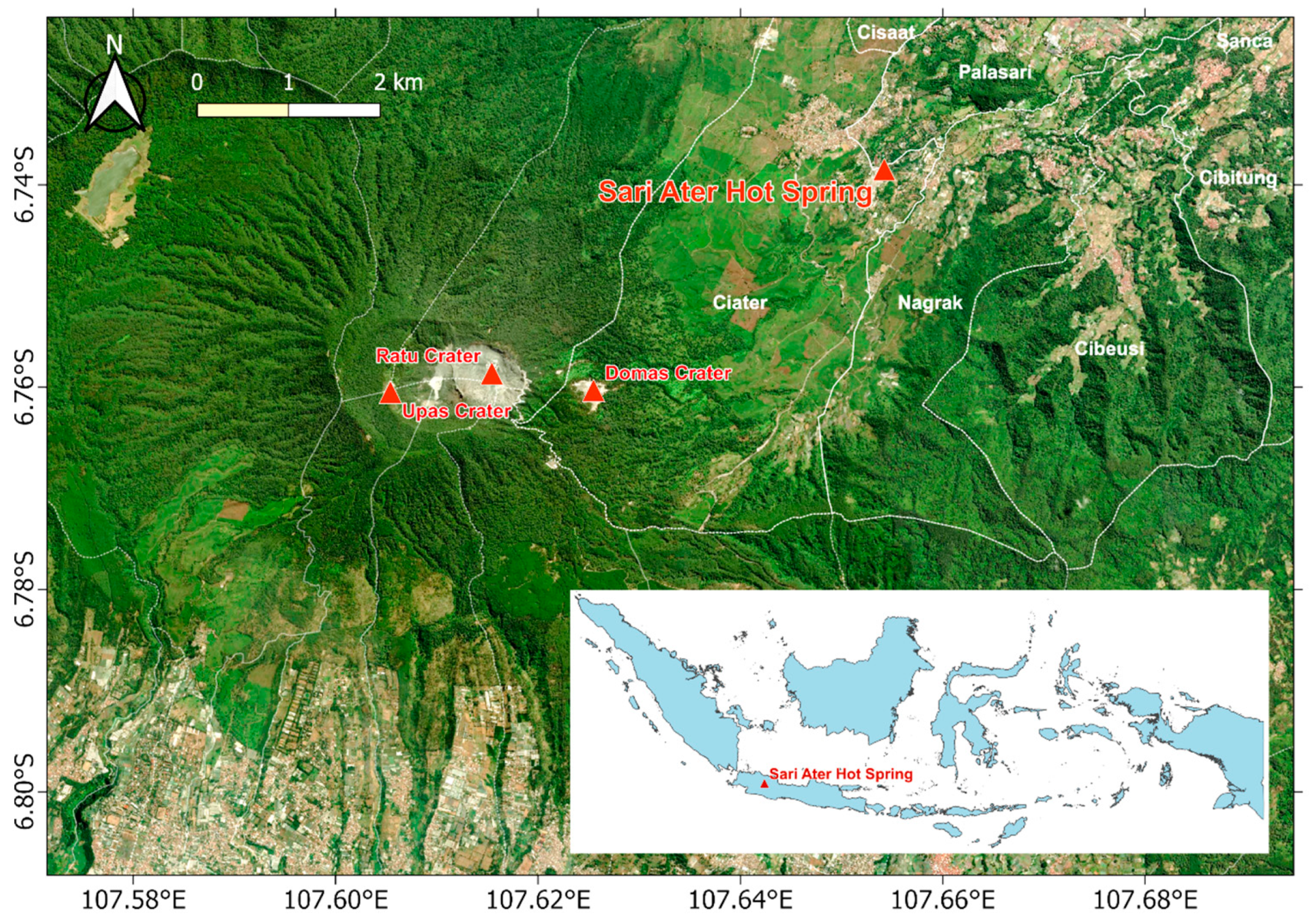

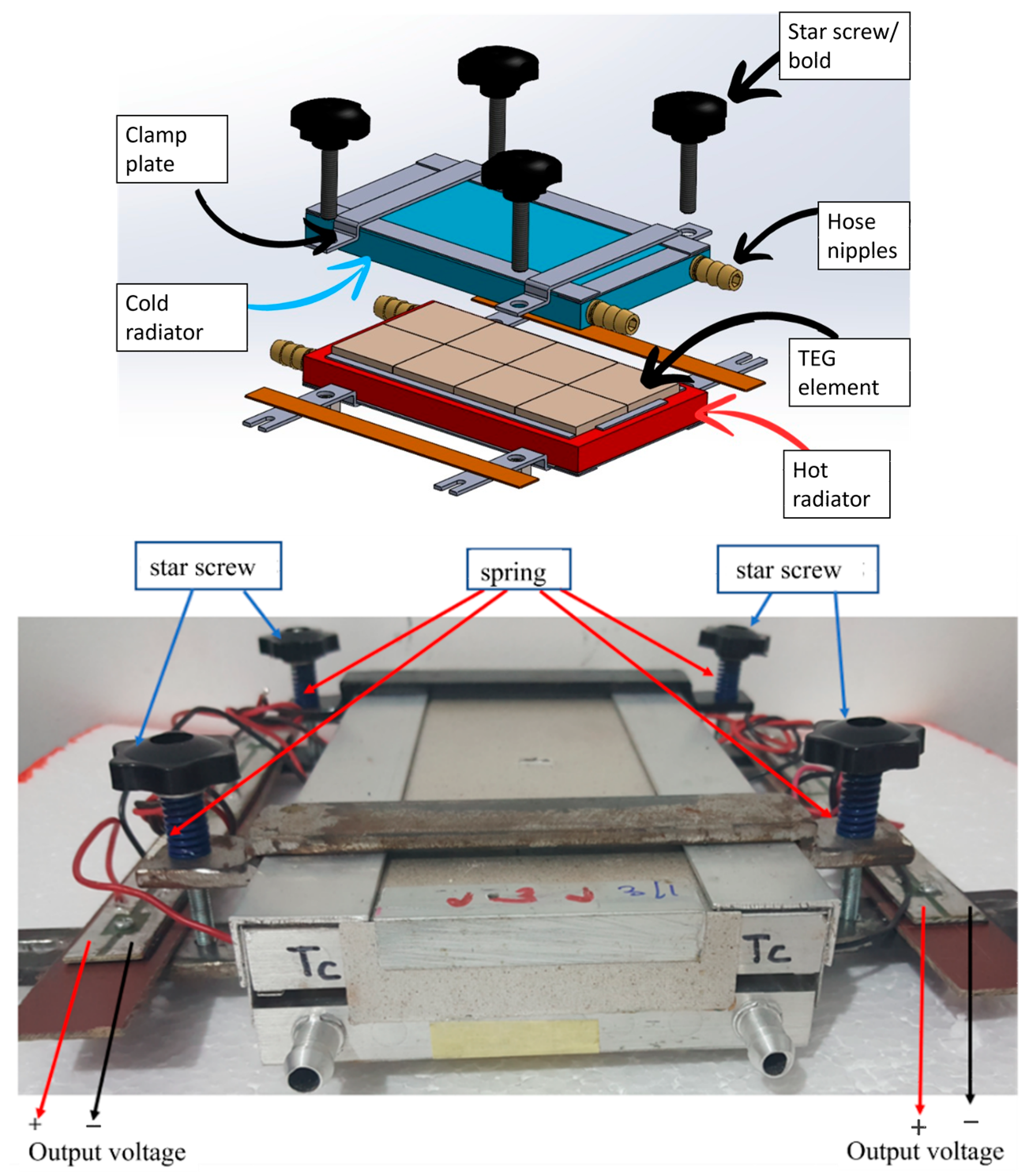

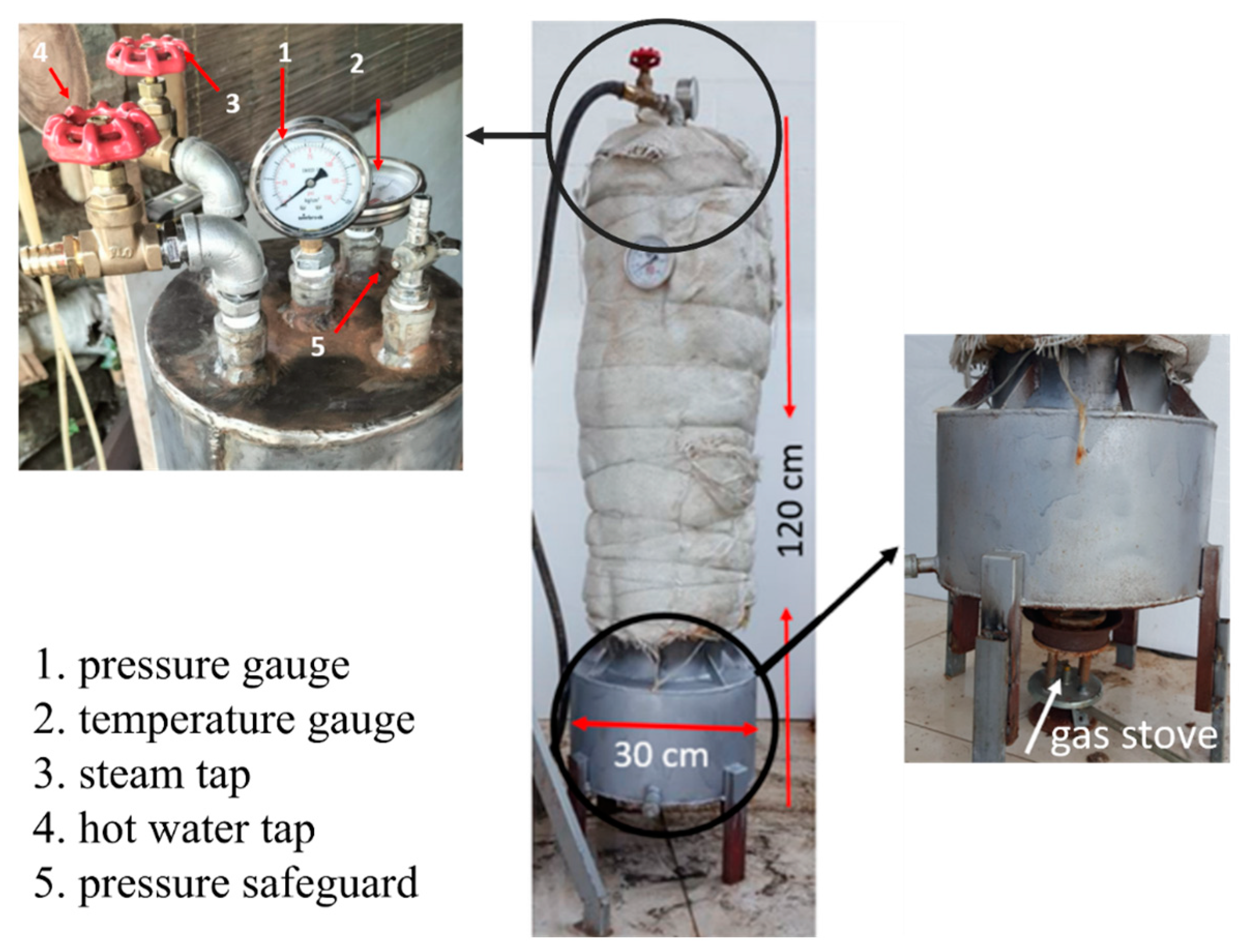
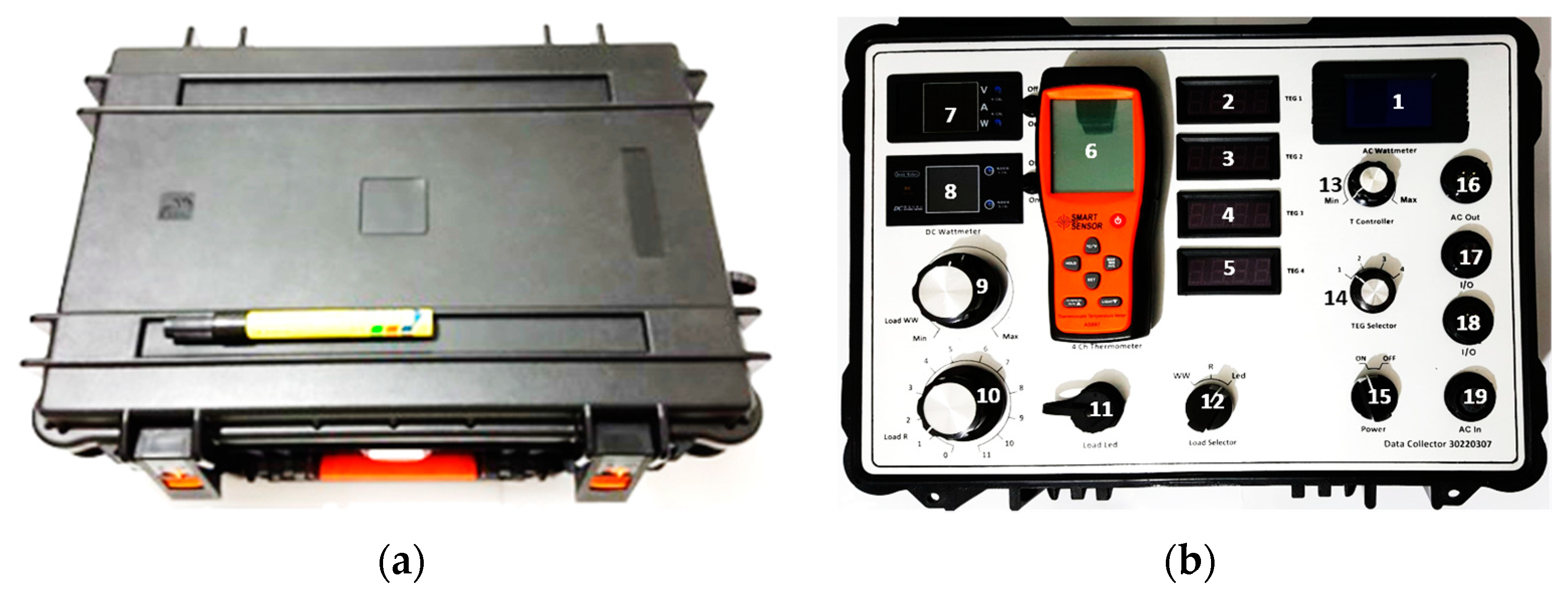
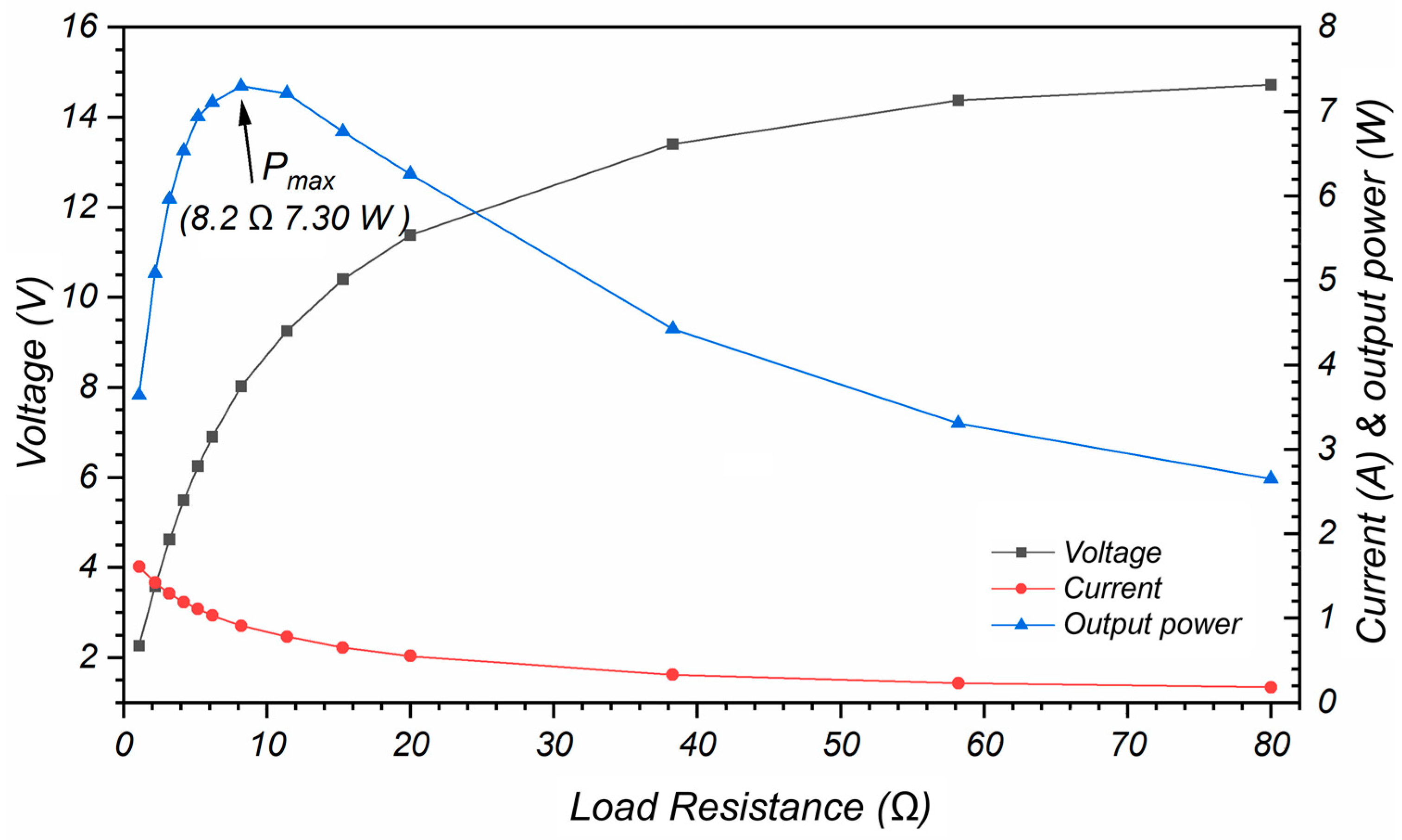
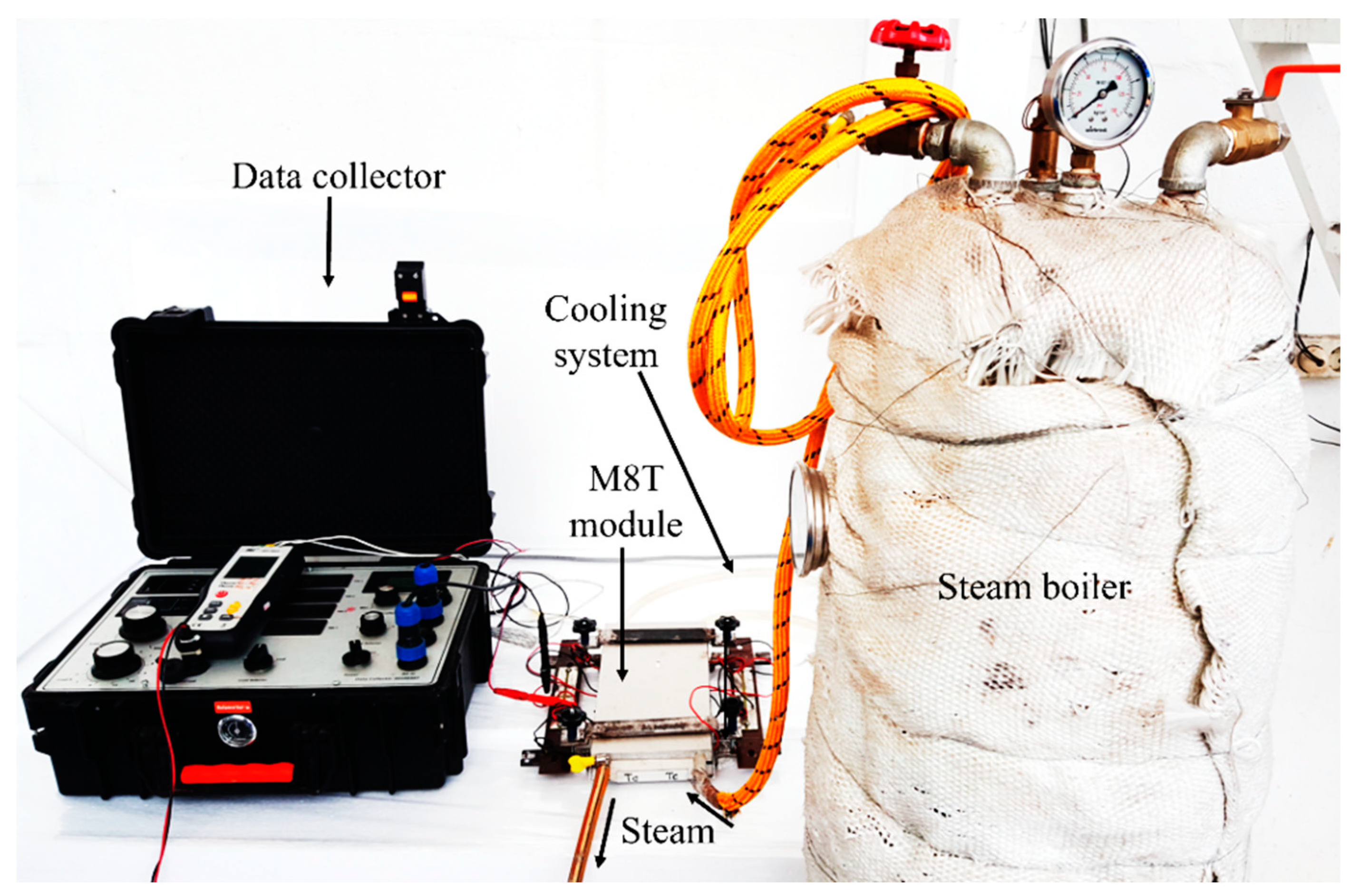


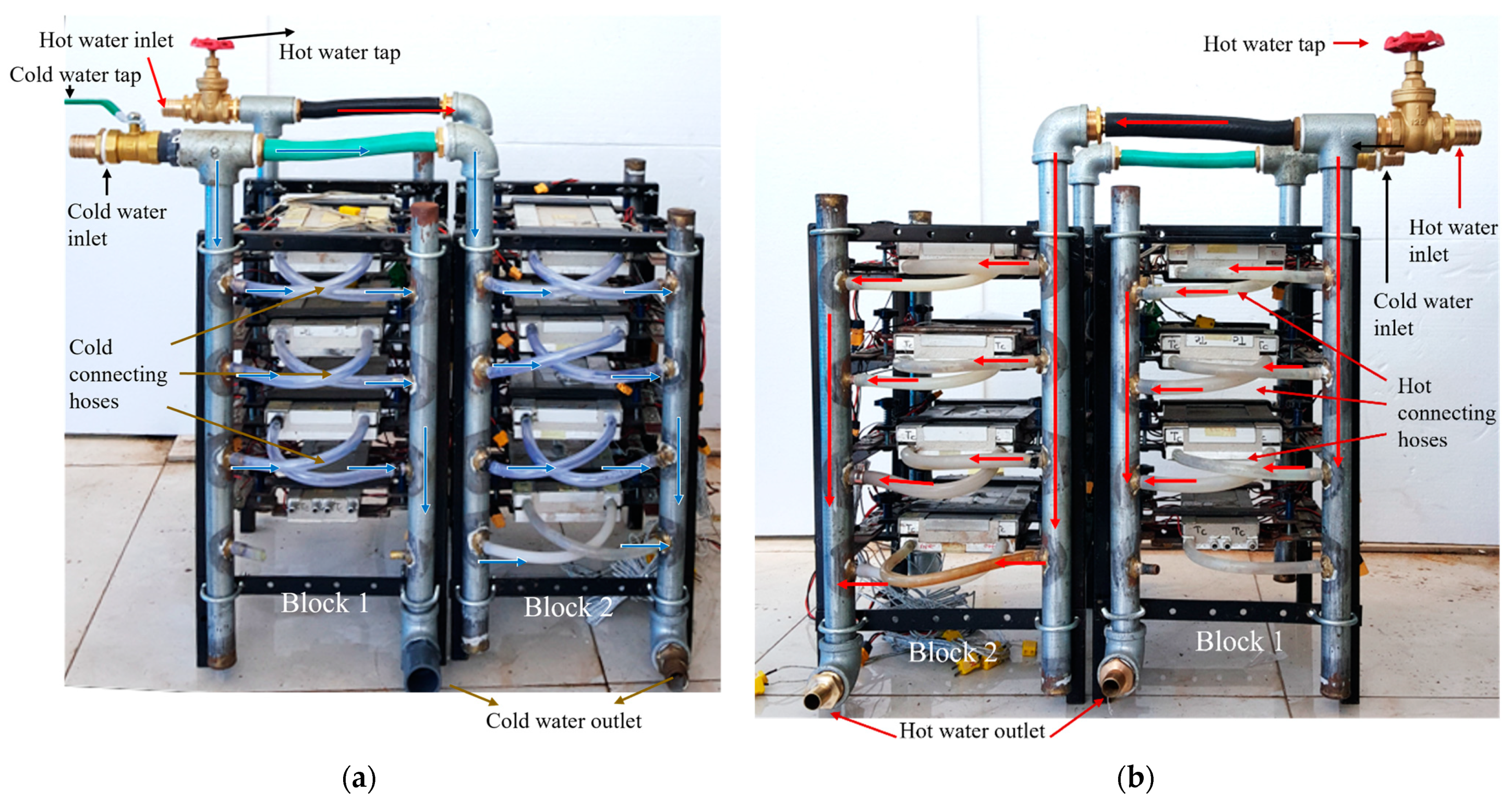
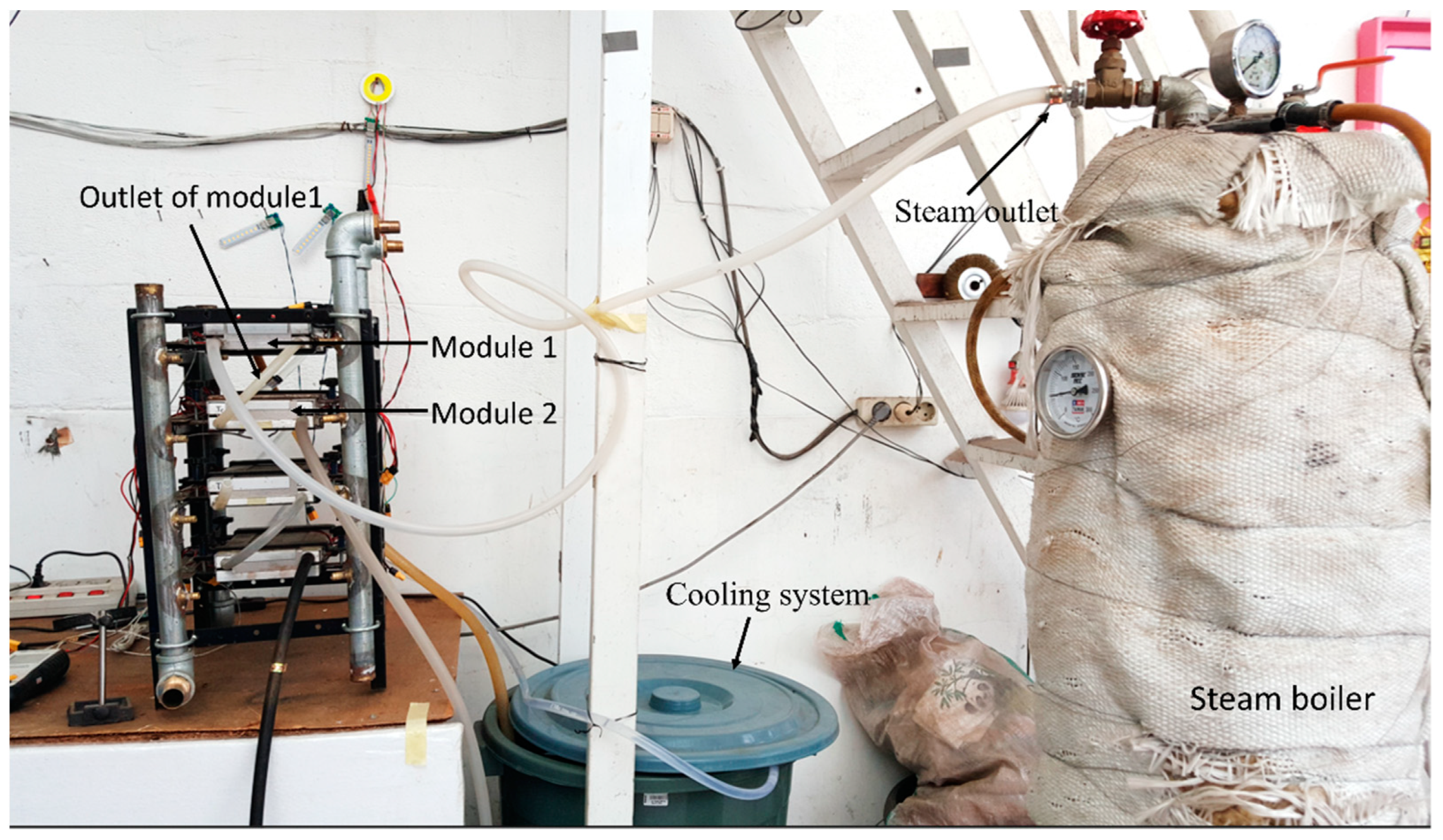

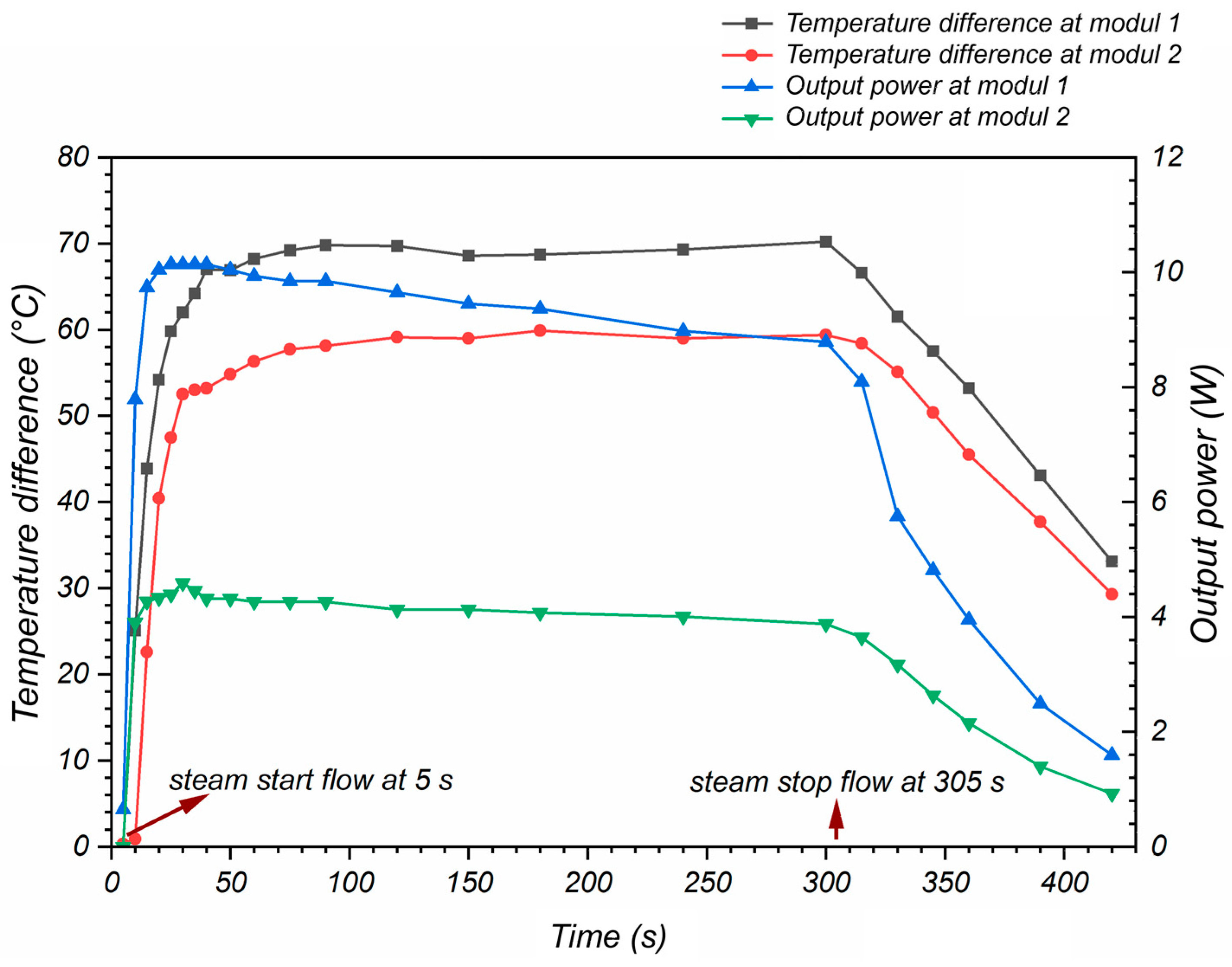
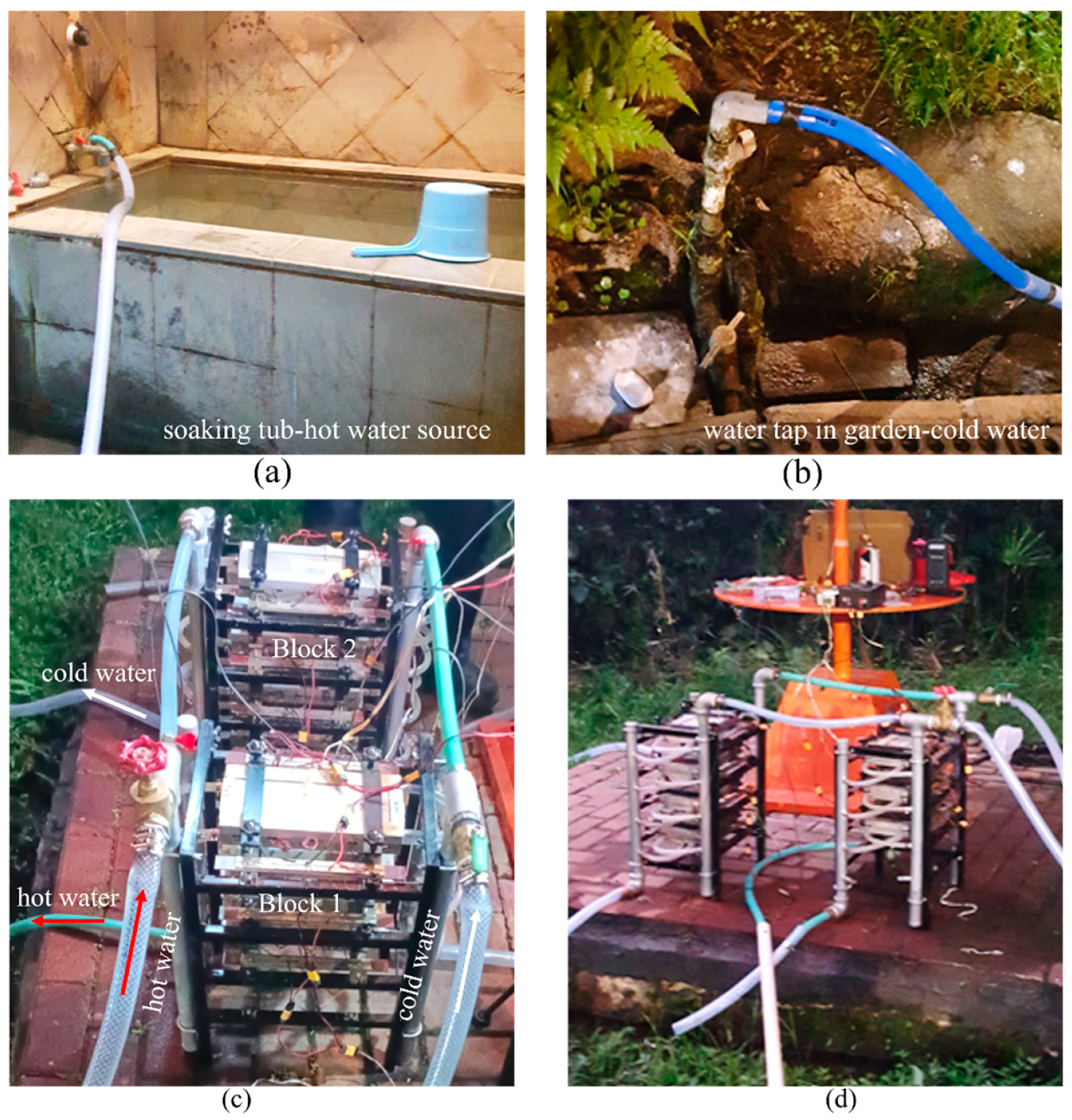
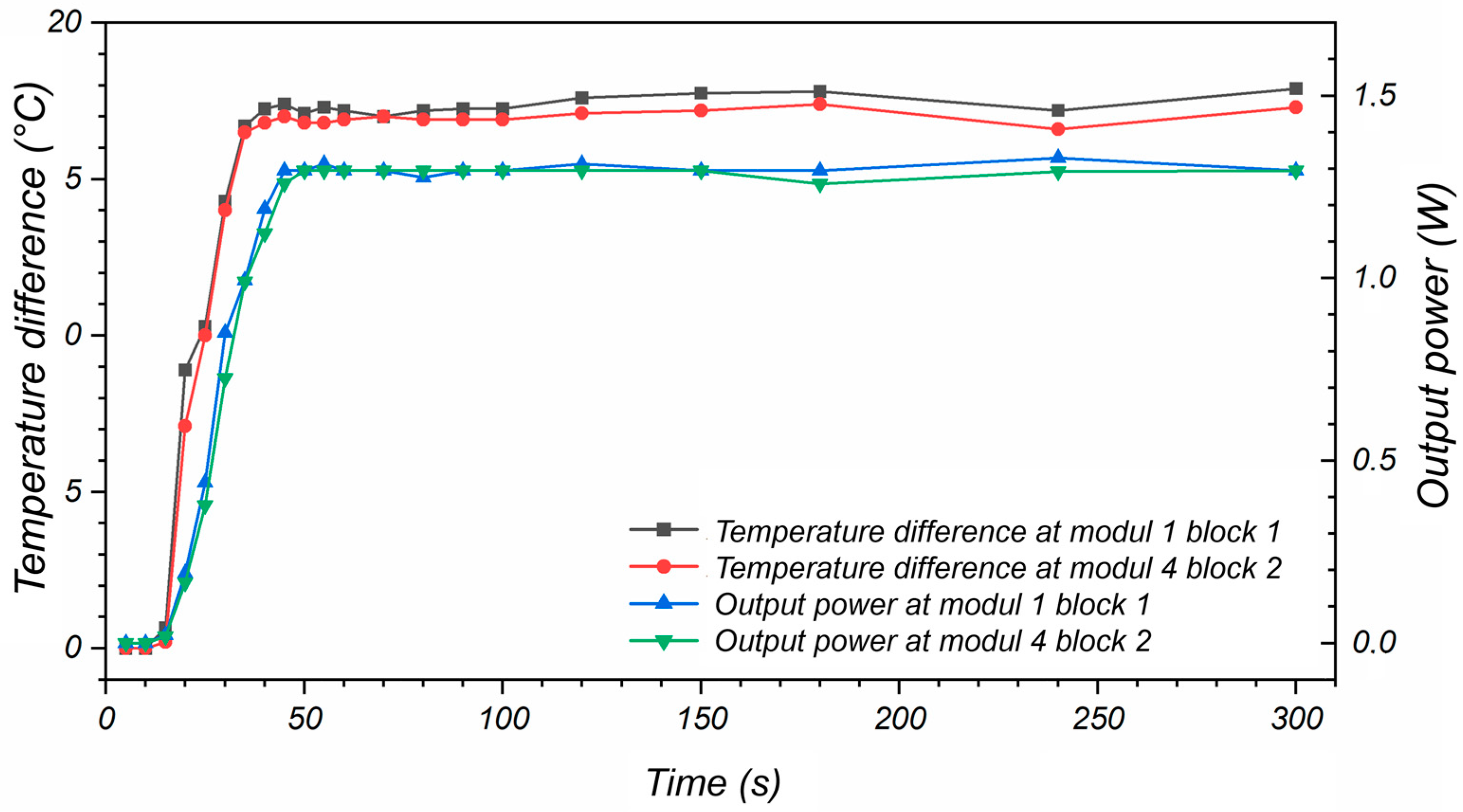
| Number of Panels | Description/Specification |
|---|---|
| 2, 3, 4, and 5 | DC voltage meter/4-digit voltmeter, range 0–100 V, accuracy: ±0.3% |
| 6 | 4-Channel digital thermometer (Tc and Th measurements)/ Smart Sensor Thermocouple 4-Channel AS887, range −200~1372 °C, accuracy: ±0.1% + 0.6 °C |
| 7 and 8 | DC power meter/DC Meter 3in1 Volt Ampere Watt 4 digits, accuracy: 1% (±1 digit) |
| 9 | Variable potentiometers for R load (0–30 Ω) |
| 10 | Rotary switch for R load (0–80 Ω) |
| 11 | LED light load sockets |
| 12 | Load selector switch |
| 14 | TEG power generation output line selector switch |
| 15 | On/off switch |
| 17 and 18 | Input/output sockets (in/out socket) |
Disclaimer/Publisher’s Note: The statements, opinions and data contained in all publications are solely those of the individual author(s) and contributor(s) and not of MDPI and/or the editor(s). MDPI and/or the editor(s) disclaim responsibility for any injury to people or property resulting from any ideas, methods, instructions or products referred to in the content. |
© 2024 by the authors. Licensee MDPI, Basel, Switzerland. This article is an open access article distributed under the terms and conditions of the Creative Commons Attribution (CC BY) license (https://creativecommons.org/licenses/by/4.0/).
Share and Cite
Marpaung, H.; Supriyadi; Lasmi, N.K.; Singarimbun, A.; Srigutomo, W. Design and Application of Low-Temperature Geothermal Thermoelectric Power Generation (Lotemg–TPG) in Sari Ater Hot Spring, Ciater, Subang, West Java, Indonesia. Designs 2024, 8, 60. https://doi.org/10.3390/designs8030060
Marpaung H, Supriyadi, Lasmi NK, Singarimbun A, Srigutomo W. Design and Application of Low-Temperature Geothermal Thermoelectric Power Generation (Lotemg–TPG) in Sari Ater Hot Spring, Ciater, Subang, West Java, Indonesia. Designs. 2024; 8(3):60. https://doi.org/10.3390/designs8030060
Chicago/Turabian StyleMarpaung, Harapan, Supriyadi, Ni Ketut Lasmi, Alamta Singarimbun, and Wahyu Srigutomo. 2024. "Design and Application of Low-Temperature Geothermal Thermoelectric Power Generation (Lotemg–TPG) in Sari Ater Hot Spring, Ciater, Subang, West Java, Indonesia" Designs 8, no. 3: 60. https://doi.org/10.3390/designs8030060





